SWITZERLAND

LUCERNE
|
ALL ABOUT SWITZERLAND |
 |
DOWNTOWN LUCERNE |
|||||
|
Swiss Cities Basel Bern Geneva Lausanne Lucerne · Hotels · History · Downtown Tour · Chapel Bridge · Spreuer Bridge · Musegg Wall · Lion Monument · Jesuit Church · Hof Church · Franciscan Church · Paulus Church · Bourbaki Panorama · Wooden Houses · Pius Church St. Gallen Winterthur Zurich Alpine Resorts Bernese Oberland Zermatt/Matterhorn Swiss Tour Chillon Castle Rhine Falls |
Downtown LucerneVirtual Sightseeing TourThis is a virtual sightseeing tour, but if you take a printout with you, it may as well serve as a guide to a real tour around the old town. Most of what belonged to the medieval city of Lucerne has been declared a pedestrian zone, so you may walk around there without being disturbed by heavy traffic.
You will find several houses decorated with façade paintings in downtown Lucerne. Most of these paintings date back to the 19th and early 20th centuries only, though façade paintings have been popular in earlier centuries already. Zoomable city map by search.ch |
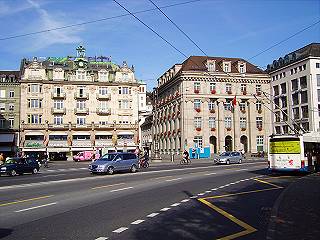 Schwanenplatz |
Schwanenplatz, situated on the right shore of Lake Lucerne/River Reuss next to the main highway bridge, is the classical starting point for visits to the old downtown area. The square itself is quite busy with traffic, but as soon as you go into the small streets of downtown Lucerne, you will enjoy the advantages of the pedestrian zone. You can easily reach Schwanenplatz by bus, most lines lead there directly, all others end at Lucerne main station (next stop on the other side of the bridge). |
 Tower at Schwanenplatz |
In earlier centuries the town ended here with a wall and a gate, and the famous wooden Chapel Bridge, now ending here, had a second part leading over shallow water to Hof Church where you now can walk under chestnut trees along the new lake shore. Both bridges were part of the fortifications. Today, there is only one tower left at Schwanenplatz. Other parts of the fortifications, namely the Musegg Wall on the north side of the medieval town, have been preserved, however. We will see some of its prominent towers during our tour. Our tour starts right at the pedestrian crossing, we go straight to the west and the second building on the left side is St. Peter's Chapel, situated at Kapellplatz. |
 Kapellplatz |
Kapellplatz, like Chapel bridge, owes its name to St. Peter's Chapel situated between the square and the bridge. The Chapel was the first church inside town, but it always remained dependant on the · Hof Church monastery and never became a parish church. Today Catholic services in foreign languages are held in this chapel. |
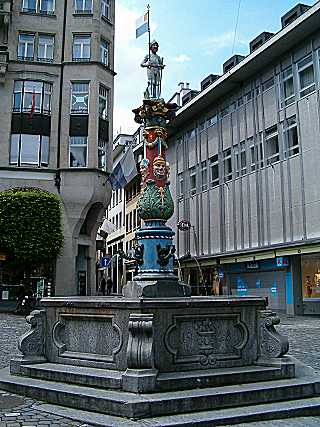 Fritschi fountain 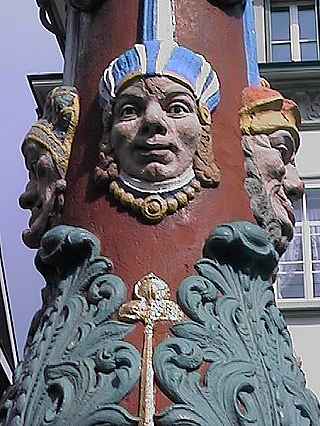 Masks of the Fritschi family |
Be sure to have a closer look on Fritschi Fountain (built 1918) on Kapellplatz. Though actually less than 100 years old, the fountain stands in the tradition of much older Renaissance style fountains with painted allegoric figures on top. You may find such fountains in any major Swiss city, particularly famous are the eleven fountains in the Swiss capital Bern. Legendary brother Fritschi plays an important role in Lucerne's Carnival tradition. Brother Fritschi's grave is supposed to be under this fountain, on the medieval graveyard attached to St. Peter's Chapel. No one knows who Brother Fritschi really was. The legend goes back to around 1450 and the most probable explanation is that there was a farmer (or farmhand) living outside town making jokes whenever he came to town. Medieval town clerk and chronist Cysat reports that Fritschi left some money to the Safran guild on condition that they serve wine to the poor during Fasacht. The guild is still fullfilling this obligation today and has dedicated one storey of their guild rooms in Nölliturm to Brother Fritschi (the location is not open to the public, however). After his death, Brother Fritschi remained very popular and was portrayed in many different ways. Among others, a figure made of straw with the features of an old man represented him. In earlier centuries, groups of young people from the other member towns of the old Swiss confederacy used to visit one of the other towns about once a year, have some sports competition and drink lots of beer and wine. Often a town's mascot, a flag etc. were kidnapped during such visits so that the hosts would have a reason to visit the town of the kidnappers soon. So Brother Fritschi as a straw figure saw some other Swiss towns ... Today two young members of the guilds dress as Brother Fritschi and his wife (the "Fritschine") on Fasnacht Thursday (Schmotzige Donschtig) for the opening ceremony. |
 Kornmarkt: Town Hall |
First mentioned in 1356, Kornmarkt was the grain market place of the city until the 19th century. The ground floor of the town hall served as a grain storage from 1438, from 1447 on the upper parts of the building served as town hall. Today the city administration is located on the other side of River Reuss, but there are still some official activities, for example marriage ceremonies (which have to take place in front of a town clerk to be valid under Swiss law). |
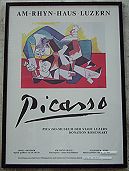 |
Am Rhyn House, built by mayor Walter am Rhyn (1570-1635), located in the narrow Furrengasse leading from the town hall back to Kapellplatz, hosts Lucerne's famous Picasso museum. Both this museum and the Rosengart collection on the opposite bank of River Reuss are donations by Mrs. Rosengart, a Lucerne art trader and collectioner. |
 Dornach house, around 1900, neo-Gothic with Mannerist fresco paintings designed by Seraphin Weingartner |
 Decorated house at Hirschenplatz |
 Weinmarkt fountain |
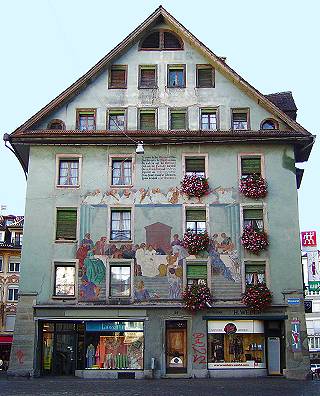 Haus zur Sonne with painted façade "Marriage at Canaan" by Eduard Renggli, 1928 |
At the Weinmarkt fountain we turn left towards the painted façade of the hotel Des Balances. There is also the restaurant zur Linde reminding us of the old linden tree that used to mark a medieval town's main square. In fact, the first town hall was located here and judgements of the local jury were pronounced from a (dismantled) balcony at this square until the late 19th century. | |
We leave this corner through the narrow Metzgerrainle [Butchers' street] towards the west and turn to the right at the Casa Tessuti. After a few steps we reach Mühlenplatz. This square is open towards River Reuss because the old city mills have been destroyed by fire in 1875. In 1887/89 new workshops with turbines driving all sorts of mechanical machinery were built, but by 1926 they were replaced by a hydro-electric power station in 1926. The power station has been completely rebuilt in 1998 and produces now some 4.3 million kWh of electricity a year - the comsumption of about 1500 families in the city.
 Spreuer Bridge and Musegg Wall towers (Männliturm and Luegislandturm) |
Wooden Spreuer Bridge with its Dance of Death paintings under the roof is certainly one of Lucerne's highlights. The bridge got its name from the fact that people were allowed to deposit Spreu [chaff] but from this bridge at the downstream end of the medieval town. Looking downstream from Spreuerbridge you can get a nice view of Nölliturm [Nölli Tower], the west end of Lucerne's famous Musegg Wall city ramparts as well as Männliturm and Luegislandturm. |
 Kasernenplatz: old house | During the middle ages, the small town (left shore part of the town) ended at this place, with the Spreuer Bridge bridgehead and the Baslertor [Basel Gate] as fortifications. Today the square is open wide, with heavy traffic approaching (and leaving) the city both on a highway and a four-lane expressway branch connected to the pan-European expressway from Germany to Italy. So we have a short look to the right (Museum of Natural history) and on the beautiful old wooden house on the opposite side of the road and quickly turn to the left. Pfistergasse [Baker street] was here in earlier times because it was near to the city mills and because the population feared fire originating in the bakeries. To the left we see Lucerne's historical museum. At the fountain at its end, we go back to River Reuss and follow the narrow, but easy-to-go path along to see the waters passing the needle weir. |
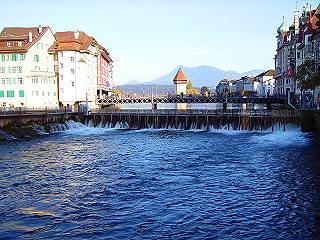 Nadelwehr (with Water Tower and Mt. Rigi in the background) | The wooden spikes of Nadelwehr are still used to regulate the water level of Lake Lucerne. Part of the fittings were destroyed during the 2005 floodings, but everything has been restored. You may tell the difference between old and replaced spikes on their color, however. |
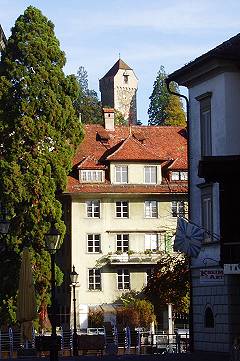 Clock Tower | At the upstream end of the needle weir we leave the river and follow Bürgerstrasse street for 70 m [100 yards] till we reach Krienbüggliplatz square with a fountain and Suidter'sche Apotheke, a prominent old house with a built in round staircase. Don't miss to turn and look back on this way from time to time - here you will get the best view on the upper part of the Clock Tower with the dial. We turn left and follow the north façade of Suidter'sche Apotheke (with the staircase) and turn right just after the building to reach Franziskanerplatz [St. Francis square]. |
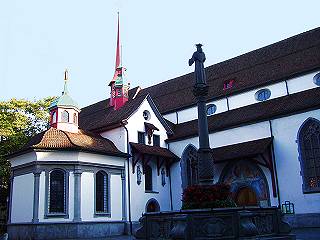 Franciscan Church | Franciscan Church, built from 1270 to 1280 in simple gothic style is Lucerne's first parish church not depending on the Hof Church monastery. While the Benedictines of Hof Church were landowners and allied to the counts of Habsburg, the craftsmen made an alliance with the peasants around Lake Lucerne in 1351. They used to meet in the Franciscain monastery and were proud to display banners used in the battles against Habsburg in Franciscan church, where you can still see them. |
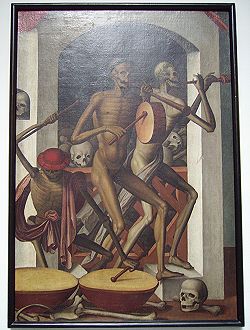 Ritterscher Palast: Dance of Death | The palace adjacent to Jesuit Church was built in Florentine early Renaissance style in 1557 by Lux Ritter, mayor of Lucerne as a mansion for his family. Following the catholic church council of Trent defining the catholic reaction on protestantism, Lucerne's government called in the Jesuit order to found a college in 1577. Rich citizens financed the college, which was set up in Ritter's Palace and a few adjecent buildings. After the 1847 civil war between conservatives and liberals in Switzerland, the Jesuits were expelled and the palace now serves as seat of the cantonal government. The building is open to the public Monday through Friday during office hours and you may see its inner courtyard featuring a three-storey loggia with Tuscan columns as well as the Dance of Death paintings on the third floor. |
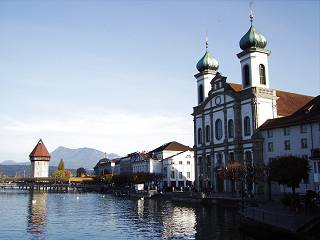 Jesuit Church and Chapel Bridge | Jesuit Church the first large Swiss church in Baroque style was built between 1666 and 1677. Opposite to the east side of Jesuit Church we find Stadttheater [city theatre]. |
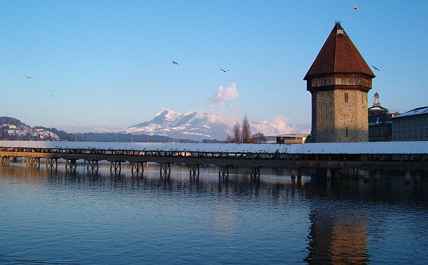 Chapelbridge with Mount Rigi | In earlier centuries the famous old Chapel Bridge was not only an important connection between the right and left shore parts of the town, but also served as part of the city fortifications. The paintings under the roof show scenes from Lucerne's and Switzerland's history. In a fire on August 18th, 1993 large parts of the bridge and 85 of the 110 paintings were destroyed, but they have been replaced by paintings from the second part of the bridge that has been dismantled in 1834 to make place for the Schweizerhofquai lakeside avenue. |

Short quotations allowed but with precise declaration of origin (Link).
Reproduction of substantial parts and pictures in printed or electronic form
only with explicit written consent by the editor.
| Disclaimer | Privacy Policy | www.all-about-switzerland.info © 2005-2010 All Rights Reserved | Editor | ||